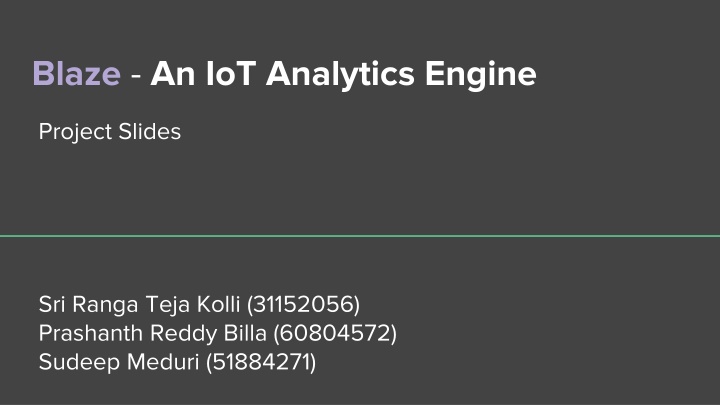
Blaze IoT Analytics Engine Project Overview
"Explore the Blaze IoT Analytics Engine project slides detailing motivation, goals, related work, user interface, and system design specifics. Learn about the framework for analyzing Internet of Things data and the technologies involved."
Uploaded on | 0 Views
Download Presentation

Please find below an Image/Link to download the presentation.
The content on the website is provided AS IS for your information and personal use only. It may not be sold, licensed, or shared on other websites without obtaining consent from the author. If you encounter any issues during the download, it is possible that the publisher has removed the file from their server.
You are allowed to download the files provided on this website for personal or commercial use, subject to the condition that they are used lawfully. All files are the property of their respective owners.
The content on the website is provided AS IS for your information and personal use only. It may not be sold, licensed, or shared on other websites without obtaining consent from the author.
E N D
Presentation Transcript
Blaze - An IoT Analytics Engine Project Slides Sri Ranga Teja Kolli (31152056) Prashanth Reddy Billa (60804572) Sudeep Meduri (51884271)
Motivation and Goals Extremely rapid expansion of Internet of Things Major service providers in the industry have or are developing custom platforms to cater to IoT We wanted analytics framework to which any IoT system can be added to. This would enable multi variant queries or analytics to be done. Goal of the project is to build an end-to-end system, and illustrate using sample use cases. Image credit: http://www.i-scoop.eu/internet-of-things/
Related Work MapReduce Processing on IoT Clouds, Ichiro Satoh Published in: 2013 IEEE 5th International Conference on Cloud Computing Technology and Science (CloudCom) MapReduce based Data Processing on IoT, Ichiro Satoh Published in: 2014 IEEE International Conference on Internet of Things (iThings) IEEE Green Computing and Communications (GreenCom) IEEE Cyber, Physical and Social Computing(CPSCom) A Data Processing Framework for Distributed Embedded Systems, Ichiro Satoh Published in: 9th International Symposium on Intelligent Distributed Computing IDC'2015, Guimar es, Portugal, October 2015
User Interface Visual Analytics and Text Results. JSON data tree view to analyze sensor information System Flow Diagram Query Interface Hive SQL Generate Intermediate Files such as CSV and Store user query, results and other information MQTT Broker Hive JDBC Driver JSON data Query Result HiveServer2 - Hive Thrift Server, Hive Driver, Metastore, Apache Derby DB MapReduce v2 JSON data Yarn Cluster Resource Management Sensor devices Hadoop Distributed File System
System Design Specifics Prototype of complete system which we have developed Sensor Data Publishing - Sensor data published to the MQTT broker Sensor Data Ingestion - The data is pulled into our Hadoop Distributed File System Hadoop and HiveServer2 - For processing the data and getting relevant information out of the huge data sets Web UI and Analytics (JSP, HTML5, CSS3, Javascript, MySQL) Login and Registration Basic Mode - We can select a specific sensor and select a specific action to be executed
Testing of our system Verify that the IoT endpoint is connected and stays live. Verify all events being generated by IoT endpoint is being received downstream. Verify that sensor data for each sensor is created properly into a separate file and pushed into HDFS. Verify if continuous ingestion of data into the JSON file works simultaneously with user queries in the User Interface and does not lead to any locking issues. Verify that during queries, a hive table with sensor schema and current data in sensor data file is created.
Evaluation Plan Comparison of response time: With the same sensor dataset pushed into relational database such as MySQL Average Execution Time: (Tmap/M) + (Treduce/N) Maximum Execution Time: Max(Tmap(i)) + Max(Treduce(j)) Minimum Execution Time: Min(Tmap(i)) + Min(Treduce(j)) Make Span: FinishTime(ReduceTask) = Time span from start to finish Delay Time: Start Time(Map Task) + Start Time(Reduce Task) - Finish Time(Map task)
Conclusion and Future Scope of our project Successfully demonstrated an end-to-end system to which any IoT environment could be connected, and different analytics could be run on the data generated by each. Incorporate additional complex learning algorithms in the analytics part. Thank You! :)
